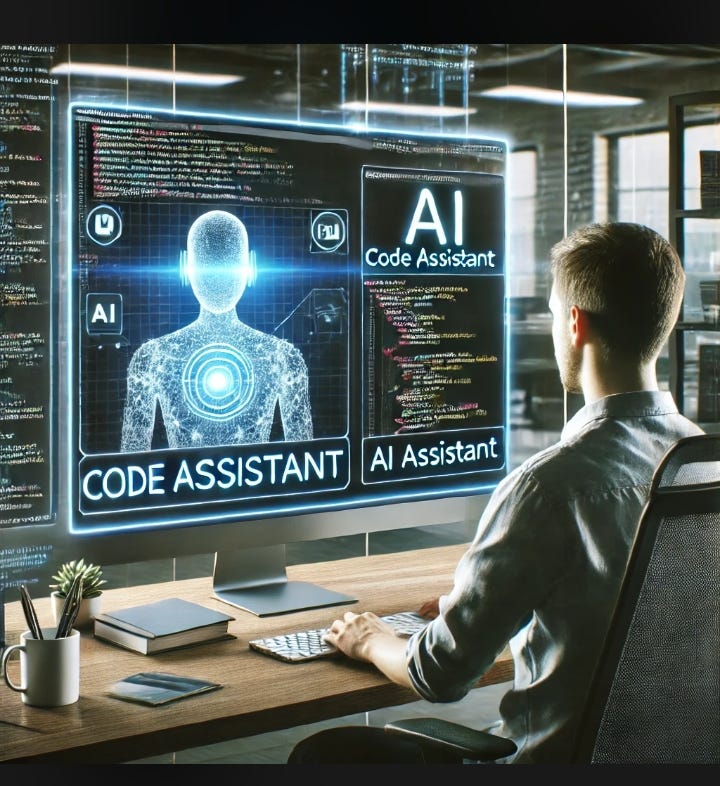The Rise of AI Coding Assistants in Software Development
In 2025, AI coding assistants have emerged as a transformative force in software development, integrating ground-breaking artificial intelligence to revolutionize how code is written, reviewed, and maintained. These intelligent tools, powered by large language models (LLMs), provide unprecedented support, from generating code to detecting bugs, significantly enhancing productivity and reshaping the development landscape.
The Evolution of AI in Software Development
The evolution of AI in software development has been nothing short of revolutionary, transforming from rudimentary rule-based systems to sophisticated neural networks capable of understanding and generating human-like code. In the early 2010s, AI’s role in coding was limited to simple autocomplete features or syntax highlighting. However, by 2025, advances in deep learning and natural language processing (NLP) have enabled AI coding assistants to grasp context, predict intent, and even write entire functions autonomously.
The breakthrough came with the refinement of transformer-based models, such as OpenAI’s GPT and Google’s Codey, which were trained on vast repositories of open-source code. These models learned not just syntax but also programming paradigms, design patterns, and best practices. By analyzing millions of lines of code, they developed an uncanny ability to suggest optimizations, detect bugs, and refactor inefficient logic—often faster than human developers.
The impact on developer workflows has been profound. Tasks that once took hours—like debugging complex issues or writing boilerplate code—are now handled in minutes. AI assistants integrate seamlessly into IDEs, offering real-time recommendations while respecting the developer’s creative control. Far from replacing programmers, these tools have augmented their capabilities, allowing them to focus on higher-level architecture and innovation.
Yet, this shift hasn’t been without challenges. Early models sometimes produced insecure or inefficient code, highlighting the need for rigorous validation. By 2025, however, continuous fine-tuning and feedback loops have significantly improved reliability, making AI an indispensable partner in the software development lifecycle. The journey from basic automation to intelligent collaboration marks a pivotal moment in how code is written—and who (or what) writes it.
How AI Coding Assistants Work
AI coding assistants in 2025 operate on a sophisticated blend of real-time analysis, vast datasets, and advanced machine learning models. At their core, these tools process code snippets as developers type, parsing syntax and semantics to provide context-aware suggestions. This is made possible by transformer-based architectures, similar to those powering large language models, but fine-tuned specifically for code comprehension and generation.
The assistants rely on two key technical pillars: static analysis and dynamic learning. Static analysis involves examining code structure, dependencies, and patterns to detect errors or inefficiencies. Dynamic learning, on the other hand, leverages reinforcement learning to adapt suggestions based on a developer’s coding style and project requirements. By cross-referencing against extensive datasets—including open-source repositories, API documentation, and historical project data—these tools generate highly relevant recommendations.
Model training plays a crucial role in their effectiveness. AI coding assistants are pre-trained on vast open-source codebases, such as GitHub’s public repositories, allowing them to recognize common patterns, best practices, and even niche programming paradigms. Fine-tuning further refines their output by incorporating domain-specific knowledge, such as industry standards or proprietary libraries. This dual-phase training ensures that suggestions are not just syntactically correct but also align with real-world use cases.
Additionally, these assistants employ contextual awareness, meaning they consider the broader project scope—such as variable naming conventions, architectural decisions, and team guidelines—before proposing changes. This minimizes friction when integrating AI-generated code into existing workflows. The result is a seamless collaboration between developer and tool, where the assistant acts as an intelligent co-pilot rather than a rigid autocomplete system.
By 2025, the underlying models have evolved to handle not just individual lines of code but entire functions, modules, and even system-level optimizations. Their ability to learn from live feedback loops—where developers accept, reject, or modify suggestions—continuously refines their accuracy, making them indispensable in modern software development.
Key Features and Capabilities
In 2025, AI coding assistants have evolved into indispensable tools for developers, offering a suite of advanced features that streamline workflows and elevate code quality. These tools now excel in code generation, leveraging contextual understanding to produce syntactically correct and logically sound snippets. By analyzing the developer’s intent, they suggest entire functions or classes, reducing boilerplate work and accelerating development cycles.
Bug detection has also reached new heights, with AI assistants scanning code in real-time to identify potential errors, security vulnerabilities, or performance bottlenecks. Unlike traditional linters, these tools provide actionable fixes, often drawing from vast repositories of resolved issues in open-source projects.
Automated code reviews ensure consistency across teams by enforcing coding standards and best practices. AI assistants compare new code against established patterns, flagging deviations and suggesting optimizations. This not only minimizes human oversight but also fosters uniformity in large-scale projects.
Another standout capability is automated documentation. AI tools now generate clear, concise comments and API references by interpreting code structure and functionality. This reduces the cognitive load on developers, allowing them to focus on problem-solving rather than mundane documentation tasks.
These features collectively enhance productivity by handling routine tasks, freeing developers to tackle complex challenges. The AI’s ability to learn from vast datasets—as discussed in the previous chapter—ensures its suggestions are both relevant and reliable. As we’ll explore next, the diversity of tools like GitHub Copilot and Tabnine further demonstrates how these capabilities integrate seamlessly into modern development environments.
Popular AI Coding Tools and Their Integration
In 2025, AI coding assistants have become indispensable tools for developers, seamlessly integrating into workflows across diverse environments. Among the most prominent, GitHub Copilot stands out for its deep integration with Visual Studio Code, JetBrains IDEs, and Neovim. Powered by OpenAI’s advanced models, it offers real-time code suggestions, function generation, and even entire boilerplate templates. Supporting over a dozen languages—including Python, JavaScript, and Go—Copilot excels in context-aware completions, reducing repetitive coding tasks while maintaining high accuracy.
Tabnine, another leader, distinguishes itself with on-premises deployment options, appealing to enterprises with strict data privacy requirements. Its AI model, trained on permissive open-source code, provides secure, high-quality completions for Java, C++, and TypeScript. Tabnine’s strength lies in its adaptability, running locally or in the cloud, and its compatibility with lightweight editors like Sublime Text and Eclipse. Developers praise its ability to learn project-specific patterns, ensuring suggestions align with team conventions.
Microsoft IntelliCode, deeply embedded in Visual Studio and VS Code, leverages Azure’s machine learning to deliver context-sensitive recommendations. Unlike generic tools, IntelliCode analyzes a project’s codebase to prioritize the most relevant APIs and patterns, particularly excelling in C# and .NET ecosystems. Its AI-assisted refactoring and style consistency checks make it a favorite for large-scale enterprise development.
These tools integrate effortlessly with CI/CD pipelines and collaboration platforms like GitHub and GitLab, bridging gaps between individual productivity and team synergy. Their adaptability across editors, languages, and deployment models underscores how AI coding assistants have evolved beyond mere autocomplete—becoming foundational to modern software development.
Impact on Developer Productivity and Workflow
The integration of AI coding assistants into software development workflows has significantly transformed productivity for both individual developers and teams. By automating repetitive tasks, these tools free up developers to focus on higher-level problem-solving and innovation. For instance, GitHub Copilot and Tabnine excel at generating boilerplate code, reducing the time spent on mundane tasks like setting up class structures or writing unit tests. This automation not only accelerates development cycles but also minimizes human error, ensuring more reliable initial code output.
Onboarding new developers has become faster and more efficient with AI assistance. Junior engineers can leverage tools like Microsoft IntelliCode to receive context-aware suggestions, helping them understand codebases and project conventions without constant supervision. AI assistants act as 24/7 mentors, providing instant explanations for unfamiliar syntax or patterns, which drastically shortens the learning curve. Teams benefit from standardized code recommendations, ensuring consistency across contributions and reducing friction in collaborative environments.
Complex problem-solving has also seen a boost. AI tools analyze vast repositories of code to propose optimized solutions for challenging bugs or architectural decisions. For example, when debugging, AI assistants can cross-reference similar issues from open-source projects, suggesting fixes that might not be immediately obvious. Pair programming is enhanced as AI acts as a real-time collaborator, offering alternative implementations and catching potential edge cases before they escalate.
However, while AI coding assistants streamline workflows, they are not a replacement for human expertise. Their suggestions require validation, and developers must maintain critical thinking to ensure code quality—a theme that will be explored further in the next chapter. The balance between automation and creativity remains key, but in 2025, AI has undeniably become an indispensable ally in software development.
Challenges and Limitations
While AI coding assistants have revolutionized developer productivity and workflow, they are not without challenges and limitations. One of the most pressing issues is their dependency on data quality. These tools rely heavily on vast datasets of existing code to generate suggestions, meaning biased, outdated, or low-quality training data can lead to suboptimal or even erroneous outputs. For instance, an AI trained on legacy codebases might propagate deprecated practices, inadvertently slowing modernization efforts.
Privacy concerns also loom large. Many AI coding assistants operate in cloud-based environments, raising questions about the security of proprietary code. Enterprises must weigh the benefits of AI assistance against the risk of exposing sensitive intellectual property to third-party platforms. Some organizations have responded by adopting on-premise AI solutions, but these often lack the scalability of cloud-based alternatives.
Another critical issue is the risk of homogenization. As developers increasingly rely on AI-generated code, there’s a danger of converging toward uniform solutions, stifling innovation. While AI excels at automating repetitive tasks, it may struggle with unconventional or highly creative problem-solving, where human ingenuity remains irreplaceable.
Human oversight is essential to mitigate these risks. AI-generated code must be rigorously reviewed to ensure correctness, maintainability, and adherence to project-specific standards. Over-reliance on automation can lead to complacency, where developers accept suggestions without critical evaluation. Striking the right balance between AI assistance and manual coding ensures that efficiency gains don’t come at the expense of code quality or creative problem-solving.
As AI coding assistants evolve, addressing these challenges will be crucial to sustaining their long-term value in software development. The next chapter will explore how ethical considerations and biases further complicate the landscape of AI-assisted coding.
Ethics and Bias in AI-Assisted Coding
As AI coding assistants become deeply integrated into software development workflows, ethical concerns and biases in their decision-making processes have emerged as critical challenges. These tools, trained on vast datasets of existing code, risk perpetuating biases present in their training material—whether in coding style, security practices, or even algorithmic fairness. For instance, if an AI assistant is predominantly trained on open-source repositories dominated by certain demographics or corporate coding standards, its suggestions may inadvertently favor those patterns, excluding diverse perspectives or reinforcing outdated practices.
One major ethical dilemma is the potential for AI-generated code to inherit vulnerabilities or discriminatory logic from its training data. A model trained on biased datasets could propagate flawed security practices or even amplify harmful stereotypes in applications like hiring algorithms or financial systems. Additionally, the opacity of some AI models makes it difficult to audit why certain recommendations are made, raising accountability concerns when errors occur.
To mitigate these risks, developers of AI coding tools are implementing several measures:
- Bias detection algorithms that scan training data for skewed patterns and flag problematic suggestions before they reach users.
- Diverse dataset curation, ensuring representation from varied coding communities and industries to reduce homogenization.
- Explainability features that provide transparency into how suggestions are generated, allowing developers to assess their validity.
- Ethical review boards within AI tooling companies to evaluate the societal impact of automated coding practices.
Despite these efforts, human oversight remains indispensable. Developers must critically evaluate AI-generated code, especially in sensitive domains like healthcare or law, where biased logic could have severe consequences. The industry’s push toward ethical AI coding tools reflects a broader recognition that technology must serve all users fairly—without compromising creativity or inclusivity. As these tools evolve, their ethical frameworks will play a pivotal role in shaping trustworthy, equitable software development practices.
The Future of Coding with AI Assistants
As AI coding assistants continue to evolve, their impact on software development in 2025 is poised to reach unprecedented levels. The next wave of advancements will likely focus on three key areas: natural language processing (NLP), full-stack development support, and interactive programming experiences. These innovations promise to further blur the line between human intuition and machine efficiency, fundamentally altering how developers write, debug, and optimize code.
One of the most transformative developments will be the refinement of NLP capabilities. AI assistants will move beyond simple code completions to understand nuanced developer intent, even when expressed in casual language. Imagine describing a feature in plain English—“create a responsive login form with OAuth support”—and the AI generating not just boilerplate code but a fully functional, secure implementation. This shift will democratize coding, enabling non-experts to contribute meaningfully while allowing seasoned developers to focus on higher-level architecture.
Full-stack development support will also see significant strides. AI tools will seamlessly navigate frontend, backend, and infrastructure code, offering context-aware suggestions that account for dependencies across the entire stack. For instance, modifying an API endpoint could trigger automatic updates to relevant frontend components and database schemas, reducing human error and accelerating iteration cycles.
Finally, interactive programming experiences will redefine collaboration between developers and AI. Real-time pair programming with AI will become more dynamic, with assistants offering proactive debugging, performance optimizations, and even alternative implementations. These tools will learn from individual coding styles, adapting suggestions to align with a developer’s preferences while maintaining best practices.
As these advancements mature, the role of developers will shift from writing repetitive code to orchestrating AI-driven workflows, ushering in a new era of creativity and efficiency in software development.
Comparative Analysis of AI Coding Assistants
In 2025, AI coding assistants have evolved into indispensable tools, each offering unique capabilities tailored to different development needs. A comparative analysis of the top contenders reveals distinct strengths, weaknesses, and ideal use cases, helping developers choose the right tool for their projects.
GitHub Copilot X remains a leader, excelling in natural language understanding and seamless integration with Visual Studio Code. Its contextual awareness and real-time suggestions make it ideal for rapid prototyping and boilerplate code generation. However, it occasionally struggles with niche languages and complex architectural decisions, relying heavily on publicly available training data.
Amazon CodeWhisperer stands out for enterprise environments, offering robust AWS integration and strong security features. It performs exceptionally well in cloud-native development but lags in open-source ecosystem support compared to Copilot. User feedback highlights its reliability for large-scale deployments but notes its limited flexibility in non-AWS workflows.
Tabnine Enterprise prioritizes privacy and offline functionality, making it a favorite for industries with strict compliance requirements. Its deep learning models provide accurate completions for Python, Java, and JavaScript, though its performance in newer languages like Rust is less polished.
Replit’s Ghostwriter dominates the educational and beginner-friendly space, offering interactive tutorials and real-time debugging. While it simplifies onboarding, advanced developers may find its suggestions too basic for complex projects.
Lastly, DeepCode (now part of Snyk) focuses on code quality and security, excelling in static analysis and vulnerability detection. It integrates well with CI/CD pipelines but lacks the generative capabilities of its competitors.
Choosing the right assistant depends on project requirements—Copilot X for agility, CodeWhisperer for AWS-centric teams, Tabnine for security-conscious organizations, Ghostwriter for learning, and DeepCode for robust code review.
Best Practices for Integrating AI Assistants into Development Workflows
Integrating AI coding assistants into development workflows requires a strategic approach to maximize efficiency without compromising code quality or developer growth. As these tools become indispensable in 2025, teams must adopt best practices to harness their potential while maintaining control over critical aspects of software development.
Balancing Automation and Manual Coding
AI assistants excel at repetitive tasks, boilerplate generation, and error detection, but over-reliance can erode problem-solving skills. Developers should use AI for:
- Rapid prototyping to test ideas without extensive manual coding.
- Debugging assistance to identify issues faster while still understanding root causes.
- Code suggestions as a starting point, refining outputs to match project standards.
Manual coding remains essential for complex logic, architectural decisions, and maintaining deep technical expertise.
Ensuring Code Quality
AI-generated code should undergo rigorous review. Teams should:
- Enforce peer reviews to validate AI suggestions against business logic.
- Use static analysis tools alongside AI to catch subtle vulnerabilities.
- Maintain coding standards by configuring AI tools to align with team conventions.
Leveraging AI for Skill Development
AI assistants can accelerate learning by:
- Providing real-time explanations for unfamiliar syntax or patterns.
- Recommending optimized solutions that expose developers to best practices.
- Simulating code challenges to help junior engineers improve.
By treating AI as a collaborative partner rather than a replacement, teams can enhance productivity while fostering continuous growth. The key is intentional integration—using automation strategically while preserving the critical thinking that defines great software engineering.

Conclusions
AI coding assistants represent a major technological leap forward, profoundly influencing the software development process in 2025. By automating routine tasks, enhancing code quality, and fostering collaboration, these tools not only boost productivity but also empower developers to focus on creative and complex problem-solving, indicating a promising future for AI in coding.



